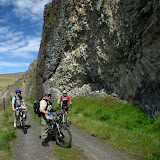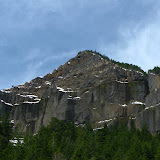
My fully loaded bike

This particular trip spawned from a discussion with Gordon. We both thought that doing the Deschutes this time of year would be perfect. Not only we would be ahead of the rafters that navigate and camp on this river but also we would get the best weather. Earlier in the season you run the risk of really cold nights and maybe some showers and later in the season of extremely hot days, this is the high desert in the end. The only thing that was keeping us from doing this trip was that it’s a long, arduous and unprotected trail (the trail follows an old rail bed), not very friendly if you want to walk the whole thing. So the idea of biking it came along and here we are.
We decided to start Later on Friday so after a nice lunch at a Mexican restaurant we found in The Dalles, we drove to the campground and got our gear ready. We didn’t know that we needed to ride back to the entrance to get on the rail bed so we started riding south from the parking lot on the river trail. Obviously we found this trail to be hike friendly but not bike friendly as we ended up doing a bit of bike-bushwhacking on the way. So as soon as we found a side trail that would take us to the actual rail bed, we took it. Unfortunately, it wasn’t a rideable trail so we had to carry our bikes and gear up the hill. It wasn’t that bad, but it certainly got our hearts pumping. This side trail got us to a rock formation with a little arch on the side of the river but it also gave us a nice glimpse at the canyon ahead of us. By this time, not only we were far enough from civilization and noise, we were alone in the trail.
View of the Canyon ahead

Now on the rail bed, we continued south and, as you’ll see in the pictures, the trail doesn’t change much although the scenery is always changing as you go thru meadows and rock walls following the river Canyon. Along the trail you also find a lot of little pieces of history about this place which makes the whole trip a lot more interesting. The first thing we found was a rail car that might be over 100 years old. It was quite incredible to see that it is in pretty good shape despite being in the same place for so long. I guess things in the past were well constructed. It was also interesting to see some wildlife using the car as shade or shelter. I was able to take a good picture of a little lizard that was sun bathing around but the little wild rabbit under the car was to shy for that.
The first rail car

We continued the ride passing by a second rail car that wasn’t in as good of a shape as the first one and some old farming equipment. Soon after that, we got to Fall Canyon, the campsite next to the river that we had picked up as our overnight resting place. Since we still had a bit of light after setting up our tents, we took a short trip further south to check out the Harris Homestead. This is quite a sight as the homestead was build over 100 years ago and it’s still partially standing. In it, you can still see signs of how life was back then. An old stove with a pan is still there as well as the remaining springs of an old mattress. Most of the walls are covered with old newspaper dated back to the 1890’s and some fabric, probably from old curtains is still visible. It almost felt like they left on vacation and never came back.
The old Harris Homestead

Our plan for the second day was to ride as far as we could, potentially to Mack’s Canyon at the end of the trail. After a nice breakfast, we took of riding south and passed the Homestead one more time. Right after it, there’s an old ranch, probably part of the same property. Although it looks much newer than the Homestead, it clearly dates back more than a couple of decades. Not too far from it, we got to the old water tank, another time mark in the trail. Most people that come visit this trail turn around here. After passing the tank, despite the fact that we hadn’t seen anybody else on the trail, we felt the trail to be even more desolated. As we continued, we passed numerous rock walls and meadows and more than a couple of times we had to stop to admire and take pictures of the wildflowers. I could try to put some of that in words but this time I’ll let the pictures do the talking




Obviously trails come to an end at some point. In our case, we got to a place where there was an old trestle but not anymore. Continuing on the trail would have required carrying the bike down a ravine and then up on the other side which looked like quite the workout. Without knowing what we would find after that, we opted for the easier choice of stopping there for lunch before heading back.
Once back at the old Water Tank, we took a detour on a very faint old road up Harris Canyon. We were on the look for another old homestead in the area that burned down not long ago. I couldn’t say we found it but I couldn’t say the opposite either. We did find some old roof panels and some rusted metal but that was it. At some point the grass got high enough that riding became hard so we left our bikes and continued on foot. To get a better view, we hiked up to the ridge overlooking Mays Canyon and Harris Canyon but did not see anything. Well, We got an incredible view of the river and surrounding canyons, but nothing of the old Mays Homestead.
Overlooking Harris and Mays Canyons

Sunday was the day to ride out. With a full day ahead of us and only about 10 miles to the trailhead, we were open to side trips. One that we had thought about was the Rattlesnake Grade. This is an old road that climbs steadily for almost 2 miles to the top of the ridge, roughly 1600’ above the river. So we rode past the second rail car to an old Trestle that is barely visible on the way in; explored around it for a while and then started riding up the grade which is just across from the Trestle. A bit further Gordon and David decided to stop and maybe explore on foot as their legs were not up for the challenge. Mark and I, on the other hand, got or gear of the bikes and continued up. I will not say the ride was easy, it was not, but the rewards were worth it. AS the road climbs and snakes we got several views of the river bellow us. At some point you get high enough that you see over the ridge on the other side of the river and Mt Hood starts to peek in the distance. That little view fueled me to continue all the way up until the road meets a closed gate. We left our bikes there and continued on foot to the end of the ridge which offer the view of the canyon bellow us, Mt Hood in the distance, the wind farms towards the Northeast and Mt Adams, further away.
View from the ridge

Yes, the ride down the grade was a lot of fun! 2 miles with 1600’ of elevation gain go by pretty fast. On our way back, we stopped one more time by the old rail car for a light bite and then we headed out. Certainly it was a change in scenery for me as most of my hikes have been in deep forests full of tall trees but considering the majority of Oregon is high desert, it was just a matter of time until I started exploring these areas. I also learned about a new outdoor sport which is very likely I will try again.




